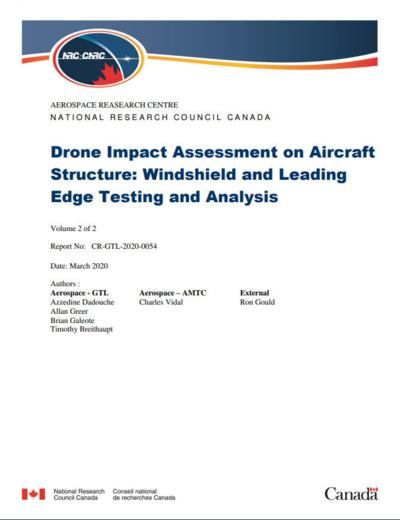Mon, Oct 05, 2020
Simulated Impacts Between A Representative Quadcopter Drone And Various Aircraft Components
Canada's NRC has been busy looking into the potential hazards created when a drone collides with an aircraft... a recently published report further documents the issue.

The report notes that, "Over the last decade, aerial drones have been increasingly used by both professional and inexperienced users resulting in an increased risk of impact incidents throughout the world. Transport Canada has already implemented regulations dealing with the operation of drones, especially in sensitive areas such as airports where a safe distance must be observed. However, the risk of impacting an aircraft at low altitude remains high from both malicious and careless operators."
The NRC Aerospace Research Centre has been performing bird impact testing both on aircraft structures, windshields as well as on engines since the 1960s where a number of pneumatic guns with various sizes have been developed and run for various clients. Over that period, NRC’s bird guns were used to fire real birds, gelatin synthetic birds as well as steel balls. The latter test aimed at certifying a bullet-proof windshield of a fighter aircraft with a firing ball velocity reaching 1.036 Mach, 668 knots.
They say that the main objective of this collaborative work between Transport Canada, Defence Research and Development Canada and the National Research Council Canada is to perform a series of experiments simulating impacts between a representative quadcopter drone and various aircraft components (windshield and wing sections) at typical operating conditions of both the aircraft and drone (impact velocity, mass and type of projectile). The wings and windshields from a typical AWM 525 (Part 25) commercial aircraft were used for these impact tests. Tests were performed at operating conditions typical for approach and cruising speeds of an aircraft under 10,000 feet.
The report gives an overall description of the test setup for windshield and wing leading edge impact testing and provides experimental data along with analysis and discussion.
It makes for fascinating reading.
More News
Touchdown Zone Lighting Two rows of transverse light bars located symmetrically about the runway centerline normally at 100 foot intervals. The basic system extends 3,000 feet alon>[...]
“Discovery and innovation are central to our mission at Virgin Galactic. We’re excited to build on our successful record of facilitating scientific experiments in subor>[...]
"We are reaching out to you today on behalf of the Popular Rotorcraft Association because we need your help. We are dangerously close to losing a critical resource that if lost, wi>[...]
UAS Traffic Management (UTM) The unmanned aircraft traffic management ecosystem that will allow multiple low altitude BVLOS operations and which is separate from, but complementary>[...]
Aero Linx: Society of Aviation and Flight Educators (SAFE) SAFE is a member-oriented organization of aviation educators fostering professionalism and excellence in aviation through>[...]
 ANN's Daily Aero-Term (05.02.24): Touchdown Zone Lighting
ANN's Daily Aero-Term (05.02.24): Touchdown Zone Lighting Aero-News: Quote of the Day (05.02.24)
Aero-News: Quote of the Day (05.02.24) Aero-News: Quote of the Day (05.03.24)
Aero-News: Quote of the Day (05.03.24) ANN's Daily Aero-Term (05.03.24): UAS Traffic Management (UTM)
ANN's Daily Aero-Term (05.03.24): UAS Traffic Management (UTM) ANN's Daily Aero-Linx (05.03.24)
ANN's Daily Aero-Linx (05.03.24)



